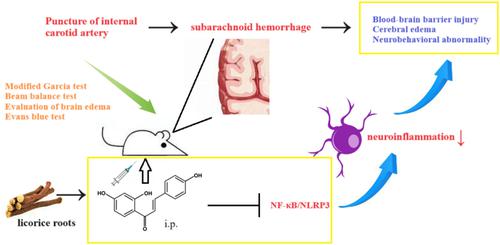当前位置:
X-MOL 学术
›
Chem. Bio. Drug Des.
›
论文详情
Our official English website, www.x-mol.net, welcomes your feedback! (Note: you will need to create a separate account there.)
Isoliquiritigenin attenuates neuroinflammation after subarachnoid hemorrhage through inhibition of NF‐κB‐mediated NLRP3 inflammasome activation
Chemical Biology & Drug Design ( IF 3 ) Pub Date : 2024-02-24 , DOI: 10.1111/cbdd.14436 Zhang Wenfei 1 , Tao Xiang 1 , Chen Chen 2 , Tao Yang 3 , Tao Yun 4 , Chen Zhibiao 1 , Zhang Ge 1
Chemical Biology & Drug Design ( IF 3 ) Pub Date : 2024-02-24 , DOI: 10.1111/cbdd.14436 Zhang Wenfei 1 , Tao Xiang 1 , Chen Chen 2 , Tao Yang 3 , Tao Yun 4 , Chen Zhibiao 1 , Zhang Ge 1
Affiliation

|
Neuroinflammation contributes to neurological dysfunction in the patients who suffer from subarachnoid hemorrhage (SAH). Isoliquiritigenin (ISL) is a bioactive component extracted from Genus Glycyrrhiza . This work is to investigate whether ISL ameliorates neuroinflammation after SAH. In this study, intravascular perforation of male Sprague–Dawley rats was used to establish a SAH model. ISL was administered by intraperitoneal injection 6 h after SAH in rats. The mortality, SAH grade, neurological score, brain water content, and blood–brain barrier (BBB) permeability were examined at 24 h after the treatment. Expressions of tumor necrosis factor‐α, interleukin‐6, Iba‐1, and MPO were measured by quantitative real‐time polymerase chain reaction (qRT‐PCR). Besides, the expression levels of NF‐κB p65 and NLRP3, ASC, caspase‐1, IL‐1β, and IL‐18 were analyzed by western blot. The experimental data suggested that ISL treatment could ameliorate neurological impairment, attenuate brain edema, and ameliorate BBB injury after SAH in rats. ISL treatment repressed the expression of proinflammatory cytokines TNF‐α and IL‐6, and meanwhile inhibited the expression of Iba‐1 and MPO. ISL also repressed NF‐κB p65 expression as well as the transport from the cytoplasm to the nucleus. In addition, ISL significantly suppressed the expression levels of NLR family pyrin domain containing 3 (NLRP3), ASC, caspase‐1, IL‐1β, and IL‐18. These findings suggest that ISL inactivates NLRP3 pathway by inhibiting NF‐κB p65 translocation, thereby repressing the neuroinflammation after SAH, and it is a potential drug for the treatment of SAH.
中文翻译:

异甘草素通过抑制 NF-κB 介导的 NLRP3 炎症小体激活减轻蛛网膜下腔出血后的神经炎症
神经炎症会导致蛛网膜下腔出血(SAH)患者的神经功能障碍。异甘草素 (ISL) 是从植物中提取的生物活性成分甘草属 。这项工作旨在研究 ISL 是否可以改善 SAH 后的神经炎症。本研究采用雄性Sprague-Dawley大鼠血管内穿孔建立SAH模型。大鼠 SAH 后 6 小时通过腹腔注射 ISL。治疗后24小时检查死亡率、SAH分级、神经学评分、脑含水量和血脑屏障(BBB)通透性。通过实时定量聚合酶链反应(qRT-PCR)测量肿瘤坏死因子-α、白细胞介素-6、Iba-1和MPO的表达。此外,通过蛋白质印迹分析NF-κB p65和NLRP3、ASC、caspase-1、IL-1β和IL-18的表达水平。实验数据表明,ISL 治疗可以改善大鼠 SAH 后的神经功能损伤、减轻脑水肿并改善 BBB 损伤。ISL治疗抑制促炎细胞因子TNF-α和IL-6的表达,同时抑制Iba-1和MPO的表达。ISL 还抑制 NF-κB p65 表达以及从细胞质到细胞核的转运。此外,ISL 显着抑制 NLR 家族 Pyrin 结构域 3 (NLRP3)、ASC、caspase-1、IL-1β 和 IL-18 的表达水平。这些结果表明ISL通过抑制NF-κB p65易位来失活NLRP3通路,从而抑制SAH后的神经炎症,是治疗SAH的潜在药物。
更新日期:2024-02-24
中文翻译:

异甘草素通过抑制 NF-κB 介导的 NLRP3 炎症小体激活减轻蛛网膜下腔出血后的神经炎症
神经炎症会导致蛛网膜下腔出血(SAH)患者的神经功能障碍。异甘草素 (ISL) 是从植物中提取的生物活性成分



























 京公网安备 11010802027423号
京公网安备 11010802027423号